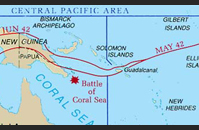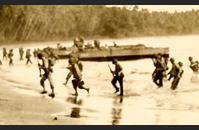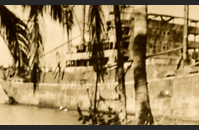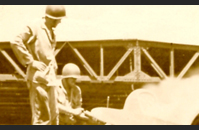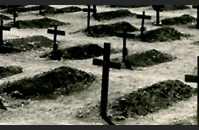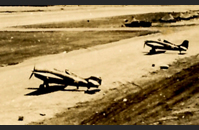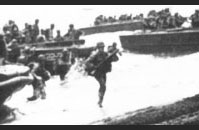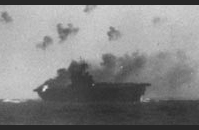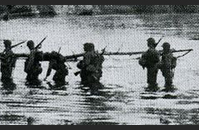THE BATTLE OF GUADALCANAL AT A GLANCE:
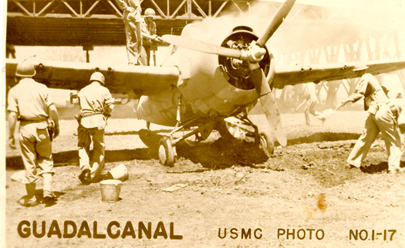
Map and Images from the Collection:
The Solomon Islands Campaign (The Battle of Guadalcanal)
Location: Guadalcanal / Solomon Islands (South Pacific)
Date: August 7, 1942- February, 9, 1943
Background: Following their attack on Pearl Harbor (December 7, 1941), the Japanese Imperial Navy occupied scores of islands throughout the western Pacific Ocean. Japan’s goal was to create a defensive buffer against attack from the United States and its Allies—one that would ensure Japan mastery over East Asia and the Pacific. After the United States’ strategic victories at the Battles of the Coral Sea (May 4-8, 1942) and Midway (June 4-7, 1942), expansion of the Japanese Empire halted. The Japanese Imperial Navy was no longer capable of major offensive campaigns and the Allies could now start their own offensive in the Pacific. The U.S. chose Guadalcanal, in the Solomon Island chain, as their first offensive campaign in the Pacific. The Solomons represented the farthest reach of Japanese territorial control in the Pacific, and would be the first of many islands the U.S. would retake in a brutal three-year island-hopping campaign to reach and defeat Japan.
The Battles
The Solomon Islands Campaign lasted six months and consisted of a number of major battles—on land, at sea and in the air. American forces first landed on the Solomon Islands of Guadalcanal, Tulagi and Florida on the morning of August 7, 1942. After some fierce fighting, the Marines cleared Tulagi and Florida by August 9. The main forces on Guadalcanal met little resistance on their way inland to secure the airfield at Lunga Point (soon to be renamed Henderson Field). Almost immediately, Japanese naval aircraft attacked transport and escort ships and Japanese reinforcements were sent to the area.
Over the following days, the first of many deadly naval battles occurred— the Battle of Savo Island. The fight for control of Guadalcanal (and with it Henderson Field) and the seas around them continued for months with both sides continuing to lose men, ships and aircraft, but with no clear winner.
As the first amphibious invasion in the Pacific, the U.S. made many initial mistakes, including not having the proper resources on the beaches to move men and material inland. The logistical challenges of transport and supply across the Pacific were immense. Difficult jungle terrain, inhospitable weather, lack of infrastructure and a foe that fought to the death, gave the U.S. its first taste of what was to come throughout the Pacific Theater of War. It seemed that every time the U.S. fought to victory, the Japanese would resupply Guadalcanal by night and be ready for more fighting the next day. But eventually, U.S. forces gained the upper hand and by February 1943, the Japanese withdrew their final men and surrendered the island to the Allies.
The Outcome
The Solomon Islands Campaign cost the Allies approximately 7,100 men, 29 ships and 615 aircraft. The Japanese lost 31,000 men, 38 ships and 683 aircraft. Over the next two and a half years, U.S. forces captured the Gilbert Islands (Tarawa and Makin), the Marshall Islands (Kwajalein and Eniwetok), the Mariana Islands (Saipan, Guam, and Tinian), Iwo Jima and Okinawa. With each island reclaimed from the Japanese, the U.S. moved closer to Japan. Growing superiority at sea and in the air, as well as in the number of fighting men, gave the U.S. increasing advantages. Nonetheless, wherever U.S. forces met Japanese defenders, the enemy fought long and hard before being defeated.
Download a printable version of this At A Glance
TAKE ACTION:


EDUCATION PROJECTS:
Student Travel – WWII Educational Tours
High school and college students, learn the leadership principles that helped win WWII on a trip to France or during a weeklong residential program in New Orleans. College credit is available, and space is limited.
See You Next Year! HS Yearbooks from WWII
Collected from across the United States, the words and pictures of these yearbooks present a new opportunity to experience the many challenges, setbacks and triumphs of the war through the eyes of America’s youth.
The Victory Gardens of WWII
Visit the Classroom Victory Garden Project website to learn about food production during WWII, find lesson plans and activities for elementary students, get tips for starting your own garden and try out simple Victory Garden recipes!
The Science and Technology of WWII
Visit our new interactive website to learn about wartime technical and scientific advances that forever changed our world. Incorporates STEM principles to use in the classroom.
Kids Corner: Fun and Games!
Make your own propaganda posters, test your memory, solve puzzles and more! Learn about World War II and have fun at the same time.


